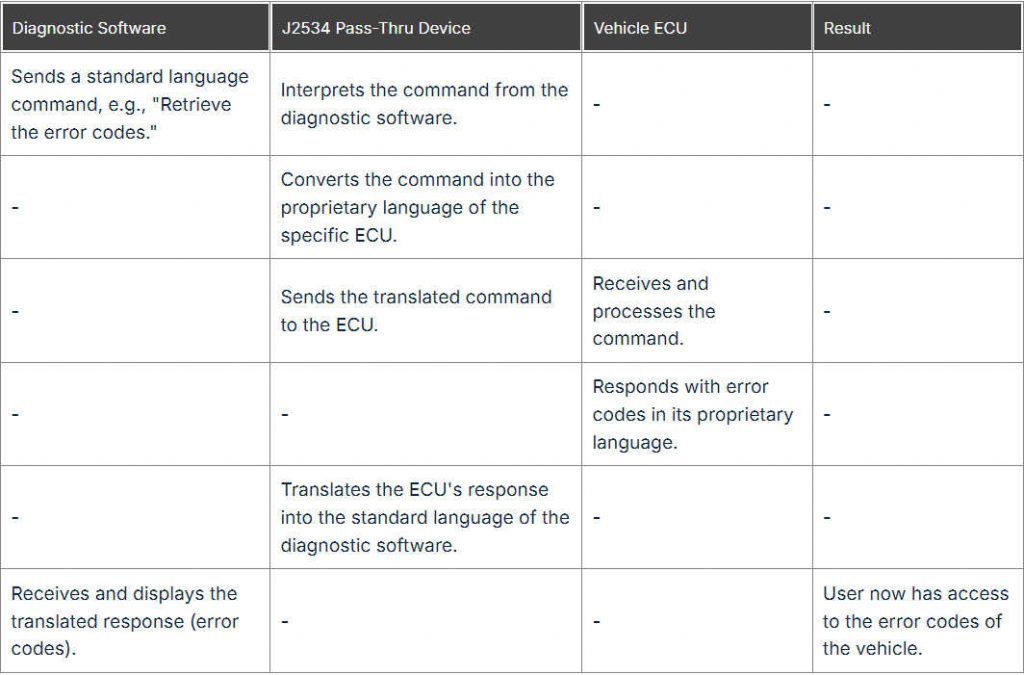J2534 is a standard that’s revolutionizing vehicle diagnostics and programming.
What is J2534?
J2534, officially known as the SAE J2534 standard, is a protocol developed by the Society of Automotive Engineers (SAE). It is designed to enable communication between a vehicle’s electronic control units (ECUs) and diagnostic or reprogramming tools.
This standard allows independent repair shops and technicians to perform diagnostics and reprogramming on various vehicle brands without needing manufacturer-specific tools.
J2534 plays a crucial role in modern vehicle diagnostics and reprogramming. Here are some key benefits:
Universal Compatibility: J2534 enables the use of a single diagnostic tool across multiple vehicle brands, eliminating the need for numerous OEM-specific tools.
Cost Savings: By using J2534-compliant tools, repair shops and technicians can reduce their investment in expensive proprietary diagnostic equipment.
Enhanced Diagnostics and Repairs: J2534 facilitates more accurate diagnostics by allowing access to a vehicle’s ECUs, leading to better repair outcomes.
Supporting the Right to Repair: J2534 promotes consumer choice and fair competition by making diagnostic and reprogramming tools more accessible and affordable.
Think of J2534 as a common language that different vehicle systems and diagnostic tools use to communicate. Just like how people from different countries might use English as a common language to understand each other, J2534 ensures that different diagnostic tools can understand and interact with a vehicle’s systems.
In other words, J2534 creates a universal method for diagnostic tools to “talk” to a car’s various systems, making it easier to diagnose and fix issues regardless of the vehicle’s make or model.
J2534-1 and J2534-2
To provide more context, it’s important to understand the differences between J2534-1 and J2534-2:
J2534-1: This is the original version of the standard, introduced to facilitate basic diagnostics and ECU reprogramming.
J2534-2: This version includes enhancements and new features, such as additional protocol support and improved reprogramming capabilities. It builds on J2534-1 to offer more comprehensive diagnostic and reprogramming functions.
By understanding these versions, you can better appreciate the evolution of J2534 and its expanding capabilities in vehicle diagnostics.
In the next section, we’ll delve into the key components of J2534 and explain how it works. This will help you grasp the technical aspects and practical applications of this powerful standard.

How J2534 Works
To understand how J2534 works, it’s essential to get acquainted with its key components—the hardware and software of J2534—and the step-by-step process it facilitates for vehicle diagnostics and reprogramming.
J2534 Pass-Thru Device: This hardware component acts as a bridge between your diagnostic tool and the vehicle’s electronic systems. It connects to the vehicle’s OBD-II port and enables the transfer of data between the diagnostic tool and the vehicle’s ECUs.
J2534 Software: This is the program running on your diagnostic tool or computer that interprets and sends commands to the vehicle’s ECUs. The software initializes communication, reads data, and performs reprogramming tasks.
Step-by-Step Guide to J2534 Communication
Now, we’ll walk you through the process of how J2534 enables communication between your diagnostic tool and the vehicle’s ECUs. From connecting the hardware to interpreting diagnostic codes and reprogramming ECUs, we’ll cover each step in detail to give you a clear understanding of how this technology works in practice.
Connect the Device
The OBD-II port, typically located under the vehicle’s dashboard, is where the pass-thru device is connected. This port serves as the gateway for communication between the vehicle’s ECUs and external diagnostic tools.
Simply plug the J2534 pass-thru device into the OBD-II port to establish a physical connection.
Activate Communication
Once the pass-thru device is connected, the J2534 software on the diagnostic tool establishes communication with the vehicle’s ECUs. This involves sending initial commands to identify and connect with the various ECUs.
The software will automatically detect the vehicle’s systems and prepare them for data exchange.
Read Diagnostic Codes
The diagnostic tool can now read DTCs stored in the ECUs. These codes indicate issues within the vehicle’s systems. The software translates these codes into understandable terms, helping technicians diagnose problems accurately.
By reading these codes, you can identify specific problems and understand the health of different vehicle systems.
Reprogram ECU
The J2534 software can also reprogram ECUs by updating their software. This process involves sending new software or calibration files to the ECUs to enhance performance or resolve issues.
Follow the prompts on the software to uploads new ECU firmware or updates, ensuring that the vehicle’s system are running the latest and most efficient versions.
By following these steps, J2534 facilitates a seamless communication process between your diagnostic tools and the vehicle’s electronic systems, enabling comprehensive diagnostics and effective reprogramming.
To further illustrate these steps, we have included a table and an image below that break down each step and provide a visual representation of the process. This will help you understand each stage more clearly and see how J2534 integration works in practice.


For more tools using J2534 pls check on our website https://www.obd2.ltd
